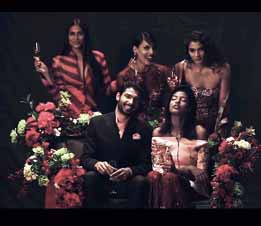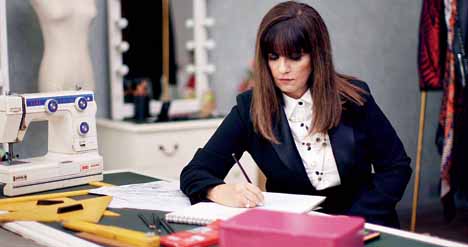Fashion designer Narendra Kumar Ahmed discusses with The Telegraph the transition in the new millennium from the sidewalk to the catwalk and trends during the lockdown and beyond as TLC’s short format series Decoded, where he talks millennial fashion, goes on air.
How are you spending time during the lockdown?
I managed to read and learn a lot more. I took a masterclass on how to make films — scriptwriting, storytelling, direction.... I also dwelt deeper in the history of fashion, reading about counter culture of fashion, which is more fascinating than mainstream fashion.
It is interesting that you are attending a film-making course. One remembers you presented a film called The Marriage of Shayla Patel at Lakme Fashion Week 2017.
I am so glad you saw it! We have made other films too. It works as we always tell stories on the ramp. In that film, a girl who has studied abroad returns home and her parents want her to marry a boy who has also studied abroad. But she loves another woman. Do I marry for love or for family? — this is the question the film asks. The show was presented in such a way that every time a character appeared on screen, a figure appeared on stage in the same clothes. It was as if the character was coming out of the screen to the ramp.
Do you foresee the screen playing a role in presenting fashion in the near future? Fashion shows are unlikely to happen anytime soon.
Up till now fashion was booming on TikTok. Now that it has been stopped (after the ban on Chinese apps), I see Instagram and social media driving a lot of fashion, democratising and making it more broad-based.
In that respect, does your role as creative director at Amazon Fashion, India, become more significant?
When I took up the job, a lot of people asked me why I wanted to work with Amazon when I was already a well-known designer. My answer was “How many people get a chance to change the way a billion people dress?” Not everyone would need a car or a house. But everyone will need clothes. That was why Amazon Fashion was created.

A still from Narendra Kumar’s film The Marriage of Shayla Patel Sourced by the Telegraph
What kinds of clothes are selling more during the lockdown?
Because people are mostly staying indoors, they are ordering innerwear and comfortable clothing like joggers, polos,
T-shirt… something that is easy to be around in while you are working from home.
Is this bad news for fashion if people buy only indoor clothes?
At some time, people will come out and meet others. Fashion will return but it will be in an avatar that is more sustainable and responsible.
Even if people are buying formals, is the demand more for tops rather than bottoms, given the only public occasions people are attending are video conferences?
Exactly. Even in normal times, the general ratio is you buy five tops to one bottom.
You launched a new line as recently as May.
Yes, the work was done before corona (struck India), just three days before lockdown actually. Since we couldn’t do much about it, we decided to put up what we had done. The red, white and black collection has a nice story also. There were riots all over India at that time. The red was for the blood that was being shed, black was for the darkness the country was moving into and white was the hope I had for the future.
Coming to the TLC show Decoded that is currently on air, did you collaborate with other designers or did each designer work on separate episodes?
The shoot happened just before Covid-19.
Every designer had a separate segment and subject. My subject was fashion in 2000 and beyond, and what inspired me. The start of the millennium saw the rise of hip-hop in music and fashion on both coasts of the US. It has come back in a new avatar. How we work with it in our collections is inspired a lot by what happened then.
What was happening in India at that time?
India was trying to find its foothold in fashion. The first fashion week was launched then. Design became an important part of popular culture. When the fashion week launched, the focus was on Indian designs. About 80 per cent of the collections was Indianwear. But around 2008-09, Indian designers started looking for validation from the West so many started doing westernwear. Even ethnicwear designers looked West.
How has that changed in the current decade?
Over the last four-five years we see a whole lot of younger Indian designers who are so confident about Indian textile, fabric, who are doing a fusion of Indian textile with Western silhouettes and pairing them with sneakers to create a youthful story that is entirely their own.
You work a lot with millennials.
Well, they are the ones who will define fashion in the next 20 years. So I thought I’d rather start at the beginning than jump in in the middle. Some 60-70 per cent of this country is below 30 and half of them are below 25. The late millennials and early Gen Z are a big market. They are going into public policy and running companies. Their values are different. The earlier mindset was ‘My clothes need to reflect my position’. Now they think ‘My work speaks for itself. I need to be comfortable in my clothes. I can fit into anything’. This confidence is going to define how we see fashion in the coming days.
You use the term athleisure a lot.
It is the phenomenon of a lifestyle based on going to the gym. Health has become an important issue. You are spending a lot of your focused time on trying to drop that one inch from your waist. What if you could bring that focus to every part of your lifestyle? Also you travel a lot. For that too you need to be comfortably dressed, not tight fits. Marriage of comfortable clothing with athletic wear is athleisure.
Does the term define the Narendra Kumar style?
Absolutely. We bring these two worlds together but make it aspirational. For instance, we create this embroidered eveningwear that you could wear to the club or the airport.
How are you telling your story in the show? Are you using footage of shows at the turn of the century or using celebrity pictures?
We are narrating the story of what was prevalent at the time and how the trends of the time affected our tastes and choices and how we have evolved. We are showing clothes, talking of the colours doing well.
Who or what were the fashion icons of the time?
Brands and designers like Calvin Klein, Armani, Polo, Ralph Lauren and Tommy Hilfiger transformed and brought down fashion to the reach of regular people.
Do you mean they brought high fashion down from the ivory tower to the streets?
Yes. Now what is happening is the reverse. Fashion is moving from sidewalk to catwalk. Street fashion is a big category that allows young people to express themselves. Designers are picking up styles from the street and showcasing them on the ramp.
Your brand FKNS stands for Fake News. Why pick such a name?
It was inspired by Donald Trump who won an election with fake news. (Laughs) I thought ‘What is the best way to capture a brand idea that could convey the spirit of the time?’ And that was Fake News!

Neeta Lulla at her workstation Sourced by the Telegraph
Ahead of the airing of Season 2 of the TLC show Decoded, which dissects fashion trends of the decades gone by, celebrity stylist Neeta Lulla talks to The Telegraph about fashion in the 80s, influence of films on fashion and reflects on the pandemic-hit present and future.
Congratulations on being nominated on the Academy Awards jury. Have they explained your role?
Thank you. They are going slow as this (pandemic) has affected the entire world. Letters are coming gradually. We have completed the process of becoming members. Other details will come later.
How have you been utilising time during the lockdown?
I have been cooking, painting, working out and working on new collections.
And you have also been going down memory lane. You have shared some heart-warming experiences with Sridevi in recent Instagram posts.
Yes, thank you. I worked with Sridevi for 14 years. We did a number of films together. I was sharing trivia on her, as much as I could remember. She has been an institution and I learnt a lot from her.
Roop ki Rani Choron ka Raja must be up there on your Bollywood list, given the number of eye-popping costumes you created for it.
Yes. And Lamhe and Chandni, too. She used to do three-four films simultaneously and we were doing them together.

An 80s look created by Neeta Lulla for the TLC show Decoded Sourced by the Telegraph
You did the episode on the 80s in the TLC show Decoded that is airing now. How would you describe fashion in the 80s?
It was a confluence of a lot of things accumulated from the 60s and 70s. International costumes came in through what one saw in books in libraries. There was no social media. Print media hardly talked about fashion. That started only in the 90s. We brought in 60s and 70s looks as well, with our own interpretations. There was a lot of influence of pop culture. The pop artistes were fashion icons and the youth emulated them — Madonna, Cyndi Lauper, Backstreet Boys... On the Indian screen, there was Parveen Babi with her kaftans, Zeenat Aman’s gogo glasses and watches in Hare Rama Hare Krishna, Shabana Azmi’s iconic saris in Lahu Ke Do Rang, Rekha’s churidar kurta in the song in Khubsoorat (Piya bawri)…
So you had a lot of on-screen material to go with when you talk of that decade.
The fact is I was also studying fashion then at SNDT University in Mumbai. As a fashion student, you keep abreast of what’s going on, be it in films, in songs, looking up old magazines in libraries...
Are you talking of fashion of both in the East and the West?
In this show, only the West.
In India, who would you say were the dominant fashion icons then?
Rekhaji and Mumtazji. Also Sadhnaji’s hairstyle. We did not have access to fashion other than what we saw on screen. So a lot of film stars emerged as fashion icons — Dev Anandji, Rajesh Khanna among the men.
Did they get the benefit of having trained fashion designers working for them like stars today do?
There were some working in films — Bhanu Athaiyaji, Leena Daruji, Shalini Shah… Fashion was not at the forefront in those days. The boom of stars’ sisters and mothers becoming designers came only in the late 80s and 90s.
Do you talk of your forte, bridalwear, in the show?
No, I just touched upon it. It deserves a separate show. (Smiles) Every bride is different in personality. A bridalwear designer needs to keep his mind and options open to the needs of the bride, apart from the glamour aspect.
How would the choice of bridalwear be affected by the pandemic?
Pricepoints will come down. Number of people attending a wedding will be less. Instead of a heavy lehnga, brides will choose a light fit, perhaps a sari, which can be reused.
How is this going to hit the fashion industry in general?
We will take a long time to get back to normalcy. We rely a lot on migrant labourers. They have all gone back home. A factory can reopen only with a certain number of people. We will have to restart slowly and gradually. I am working with only five to six people in the workshop now.










